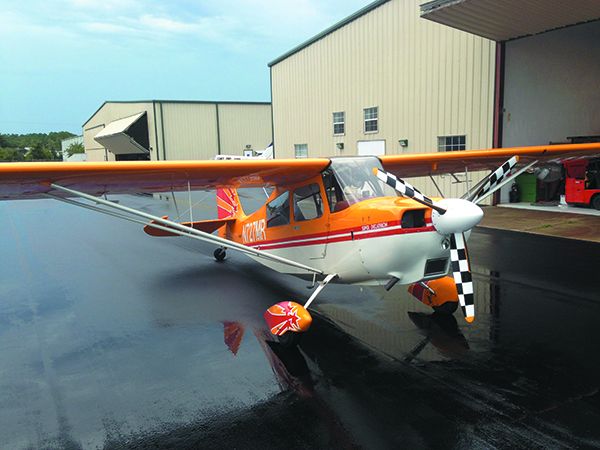In a matter of less than three decades composite props have gone from interesting curiosities on homebuilt airplanes to widely accepted original equipment on new production airplanes and almost universally available aftermarket replacements for metal props on legacy birds.
While still more expensive than their aluminum counterparts, the advantages of composite propellers in terms of weight, efficiency, ability to hold a complex airfoil, longevity, reduced vibration and—in many cases—increased performance means that their popularity has steadily increased.
OK, so what are the details? What are they—and what can they do for an aircraft owner, who makes them, what do they cost and how do you take care of them once you hang one on the nose of your air machine?
WHAT’S IN ONE
To start with, a composite prop has blades made at least partially of layers of epoxy Fiberglas, Kevlar or carbon fiber. The composite material is on top of a core that is either hollow (rare) or made of wood or foam. The ferrule (base) of a constant speed prop is generally steel or aluminum and fits into a hub that is largely identical to a prop with aluminum blades. A fixed pitch composite prop often has no metal at all.
In the airframe world, the FAA moved slowly and conservatively on composite certification, insisting on what we believe to be overly strong structures—with the result being that the hoped-for weight savings didn’t happen. Fortunately, in the propeller world that wasn’t such a problem—leading to the development of thin, extremely strong blades that were capable of holding more complex shapes than aluminum while weighing much less than aluminum. As we did our survey for this article we routinely saw weight savings from 5 to 20 pounds—the greatest we spotted was 35 pounds.
The weight saving occurs at one end of the center of gravity envelope and requires some accommodation when loading aft-tending CG airplanes such as a Bonanza. By the same token, as the CG moves aft, cruise speed increases.
Another benefit of reduced prop weight is less gyroscopic and flywheel effect—reducing wear and tear on the engine, especially the crankshaft and engine mounts. That was one of the biggest considerations in causing aerobatic aircraft owners to be some of the earliest to hang composite props on their airplanes.
As we spoke to owners and shops about composite props we were repeatedly told that they felt that their props were increasing engine life. We were unable to obtain any hard data on the subject.
MORE BLADES
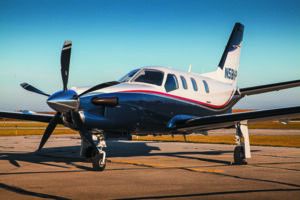
If a composite prop is lighter than its aluminum counterpart, why not increase the number of blades on the composite one? About 30 years ago prop makers began producing three-bladed (and then four-bladed) aluminum props to replace the two-bladed (or three-bladed) propellers hung by the airframe manufacturer before shoving the airplane out of the door. They weighed more, but reduced vibration, often had greater ground clearance because the blades were shorter and usually improved the rate of climb. Cruise performance diminished a little on aircraft with engines of less than 230 HP and stayed about the same on others. They were also more expensive than the original prop.
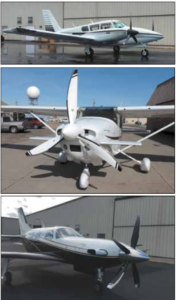
However, props with more blades looked way cool. Performance didn’t matter, looking cool did.
They sold. Well.
Eventually the prop makers found that sweeping the blade slightly—becoming known as scimitar props—bumped up cruise speeds.
With the ability of composites to hold complex curves and more radical blade sweep, increasing the number of blades while keeping weight at or below the OEM aluminum prop has meant nothing but good things: better performance on takeoff, climb and cruise, lower vibration, less noise both inside the cabin and out and more ground clearance because the blades are shorter.
VIBRATION
While more blades equal less vibration, vibration on foam-core composite props is also reduced because the core absorbs some of it. Finally, with multiple blades, the engine power pulses are spread over more blades, reducing the momentary loads on the airframe from the engine pulses, benefiting airframe life.
We have not heard any reports of loss of performance from owners who have switched to multi-blade composite props. The reports we have gotten have been to the contrary—the more precisely molded, multiple-blade composite propellers are able to convert more of the engine’s power to thrust, improving all areas of performance while looking very good.
You want lots of blades? MT-Propeller makes a seven-blade prop for the Pilatus PC-12.
We noted that for most of the piston general aviation aircraft, composite prop STCs provide information on operation and care of the new prop, along with limitations, but nothing on performance, so what we have is word of mouth before-and-after reports by owners. We consider reports of performance increase to be accurate—although we’re always skeptical as to amounts—because we’ve experienced some and because owners reported cruise speed decreases when they went to three-blade metal props.
We are aware of the phenomena of owners badly wanting to justify shelling out for a mod and seeing the results with rose-colored glasses. In the world of multi-bladed composite props the performance increases for piston-engine airplanes appear to be very real.
For turboprops, the prop manufacturers are documenting the new performance numbers in the STC paperwork, giving an objective report of the performance improvements.
On the performance end we did hear reports of better performance at lower operating RPMs. It’s been known for some time that turning props over 2000 RPM is too fast for maximum efficiency and performance. On that score, we heard from some owners that their new composite props seemed to be most efficient at lower RPM settings. Peter Marshall, vice president of MT-Propeller (www.mt-propeller.com), recounted his experience in a Cessna 182 in which reducing RPM from 2400 to 2200 (and manifold pressure from 24 inches to 22) resulted in reducing fuel burn by 2 GPH but only slowing by 5 knots.
THE LEADING EDGE
We recall the growing pains of early composite prop installations in the 1980s with airplanes such as the Cessna Caravan and Saab-Fairchild 340 where reports of erosion of the blades in rain became almost common and led to development of an aluminum prop for the Caravan that was popular until the issues with the lighter composite unit were resolved. From what we have been able to tell, issues of composite blade erosion in precip haven’t been around for over 20 years.
All composite props of which we are aware have some sort of leading edge protection to prevent blade erosion—usually nickel or steel.
MT-Propeller uses a nickel cobalt leading edge, reported by Peter Marshall to be six times harder than aluminum. According to Marshall, “stuff bounces off” the leading edge; accordingly, they don’t see blade damage. Of the thousands of propellers sold, Marshall said that he’s only aware of seven times that leading edges have had to be replaced.
MT-PROPELLER

MT-Propeller started selling its composite props in the U.S. in 1981 and opened a U.S. office in 1999 as demand grew and there was a need to be able to provide props without a buyer having to wait for shipment from Germany.
Its props are referred to as a natural composite—being made up of layered and compressed beech and spruce wood in which epoxy is injected to create a very dense core of what MT’s Marshall described as “compreg wood.” The core is then reinforced with layers of Kevlar, carbon fiber or Fiberglas shaped precisely to obtain the desired airfoil and then sealed with acrylic polyurethane paint. An aluminum blade ferrule is attached to the wooden core with lag screws.
Marshall told us that compared with an aluminum three-blade prop, the MT prop is 20 pounds lighter.
MT entered the market building props for aerobatic airplanes but rapidly expanded into turboprops and then the nonaerobatic piston word. MT has aggressively obtained STCs to the point that it has them for over 250 airplanes. When we looked at the list on its website it appeared to us there are not many airplanes for which it does not have an STC.
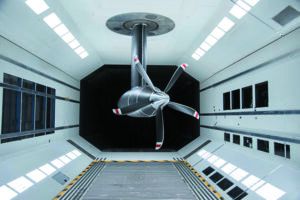
Peter Marshall told us that they had just obtained an STC for the Piper Seneca I (the only nonturbocharged Seneca), an increasingly rare airplane used primarily for multi-engine training. Marshall said that Seneca I owners were facing a situation where no one was making propellers for them anymore and the supply was drying up. He said that he was involved in some of the flight testing and noted that with the MT prop the airplane would climb to 8,800 feet on one engine, some 5000 feet higher than it would with aluminum props.
As with other composite props, MT propellers have no blade life limit. They are never filed in service—as are aluminum props—so they never become undersize and need to be discarded.
In speaking with Marshall we observed that MT’s approach over the years has been to “add a blade” when developing STCs—where the OEM equipment was two blades, MT went to three, where it was three, MT went to four.
For pricing it’s necessary to contact MT. We inquired for the Cessna 182—$17,000—and the Mooney M20F—$15,000.
HARTZELL
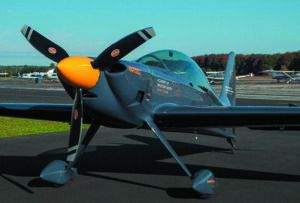
Hartzell (www.hartzellprop.com) marketed its first composite prop—for the CASA-212 regional airliner—nearly 45 years ago. It was constructed using a prepreg layup system and was the first of what it refers to as its legacy props—and is still in production.
Construction of the prop starts by bonding a metal shank into a foam core. The core is covered with prepreg material laid up by hand—carbon fiber and/or Kevlar—and then the assembly is put into a press. Following the curing process, there are a number of operations, including bonding on a nickel-cobalt erosion shield. This creates what is referred to as a structural composite—a semi-monocoque, stressed shell structure.
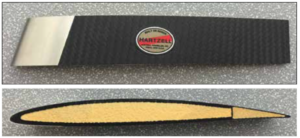
ADVANCED COMPOSITE
In 2006, Hartzell developed its Advanced Structural Composite (ASC) II prop for the Cirrus SR22T. It uses a dry carbon fiber lay up rather than prepreg. A sock is pulled over the foam core and a vacuum-assisted resin transfer process pulls the resin through the dry fibers in the mold. It also allows molding in the items that must be added post-cure in the legacy props, such as the erosion shield. Once an ASC II prop comes out of the mold, all that remains to be done is remove the flashing and add the finish coatings—cutting production time and cost substantially.
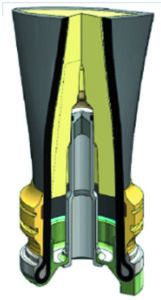
AIRLINERS FIRST
Hartzell originally developed its composite propellers for the airline industry because it could afford the development costs and badly needed propellers that could be repaired at outstations after suffering the kind of damage that routinely occurs in high-usage operations, such as being hit by baggage carts.
Pricing can be found on Hartzell’s website, although the search is not easy. We saw a price of $21,500 for a three-bladed composite prop for a Cessna 182. We recommend contacting Hartzell directly for pricing information as some installations may require additional equipment such as a new prop governor.
Hartzell is also aggressively obtaining STCs and has done so for a large percentage of current and legacy general aviation piston and turboprop airplanes.
MCCAULEY
McCauley (www.mccauley.txtav.com) has long been known for its aluminum propellers. It dipped a toe into the composite world with a propeller for the Cessna Skycatcher. In 2015 it received FAA certification for a three-blade composite prop targeted at piston-engine airplanes up to 350 HP; however, the company never seemed to push the prop into the market and it is no longer even mentioned on its website.
With its current focus on a five-blade composite prop for the Beechcraft Denali turboprop twin, we’re watching to see whether McCauley is going to remain in the piston-engine airplane composite world.
CONCLUSION
While composite replacement props are more expensive than aluminum OEM equipment, we are of the opinion that the increased performance, lower weight, long life, ease of maintenance, reduced vibration, better ground clearance, reduced engine stress and reduced noise level make them extremely attractive, especially for someone facing the need to replace an existing propeller.

